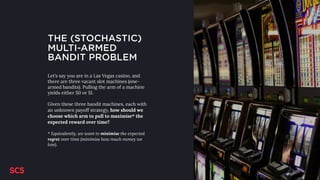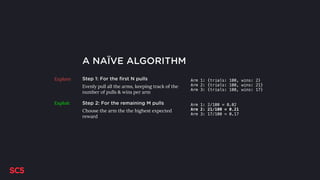Bandit Algorithms
- 1. BANDIT ALGORITHMS Max Pagels, Data Science Specialist [email protected], @maxpagels 13.10.2016 Learning about the world
- 2. PROGRAMMING, IN A NUTSHELL OUTPUTINPUT ALGORITHM
- 3. MACHINE LEARNING, IN A NUTSHELL PROGRAMINPUT & OUTPUT LEARNING ALGORITHM
- 4. REINFORCEMENT LEARNING, IN A NUTSHELL ACTION WORLD OBSERVATION AGENT REWARD
- 5. LEARNING HOW TO PLAY TETRIS ACTION WORLD OBSERVATION AGENT REWARD (Rotate/Up/Down/ Left/Right etc) Score since previous action
- 6. THE (STOCHASTIC) MULTI-ARMED BANDIT PROBLEM Let’s say you are in a Las Vegas casino, and there are three vacant slot machines (one- armed bandits). Pulling the arm of a machine yields either $0 or $1. Given these three bandit machines, each with an unknown payoff strategy, how should we choose which arm to pull to maximise* the expected reward over time? * Equivalently, we want to minimise the expected regret over time (minimise how much money we lose).
- 7. FORMALLY(ISH) Problem We have three one-armed bandits. Each arm yields a reward of $1 according to some fixed unknown probability Pa , or a reward of $0 with probability 1-Pa. Objective Find Pa, ∀a ∈ {1,2,3}
- 8. OBSERVATION #1 This is a partial information problem: when we pull an arm, we don’t get to see the rewards of the arms we didn’t pull. (For math nerds: a bandit problem is an MDP with a single, terminal, state).
- 9. OBSERVATION #2 We need to create some approximation, or best guess, of how the world works in order to maximise our reward over time. We need to create a model. “All models are wrong but some are useful” — George Box
- 10. OBSERVATION #3 Clearly, we need to try (explore) the arms of all the machines, to get a sense of which one is best.
- 11. OBSERVATION #4 Though exploration is necessary, we also need to choose the best arm as much as possible (exploit) to maximise our reward over time.
- 12. THE EXPLORE/EXPLOIT TUG OF WAR
- 13. HOW DO WE SOLVE THE BANDIT PROBLEM?
- 14. A NAÏVE ALGORITHM Step 1: For the first N pulls Evenly pull all the arms, keeping track of the number of pulls & wins per arm Step 2: For the remaining M pulls Choose the arm the the highest expected reward
- 15. A NAÏVE ALGORITHM Step 1: For the first N pulls Evenly pull all the arms, keeping track of the number of pulls & wins per arm Step 2: For the remaining M pulls Choose the arm the the highest expected reward Arm 1: {trials: 100, wins: 2} Arm 2: {trials: 100, wins: 21} Arm 3: {trials: 100, wins: 17} Arm 1: 2/100 = 0.02 Arm 2: 21/100 = 0.21 Arm 3: 17/100 = 0.17
- 16. A NAÏVE ALGORITHM Step 1: For the first N pulls Evenly pull all the arms, keeping track of the number of pulls & wins per arm Step 2: For the remaining M pulls Choose the arm the the highest expected reward Arm 1: {trials: 100, wins: 2} Arm 2: {trials: 100, wins: 21} Arm 3: {trials: 100, wins: 17} Arm 1: 2/100 = 0.02 Arm 2: 21/100 = 0.21 Arm 3: 17/100 = 0.17 Explore Exploit
- 17. EPOCH-GREEDY [1] Step 1: For the first N pulls Evenly pull all the arms, keeping track of the number of pulls & wins per arm Step 2: For the remaining M pulls Choose the arm the the highest expected reward Arm 1: {trials: 100, wins: 2} Arm 2: {trials: 100, wins: 21} Arm 3: {trials: 100, wins: 17} Arm 1: 2/100 = 0.02 Arm 2: 21/100 = 0.21 Arm 3: 17/100 = 0.17 Explore Exploit [1]: http://hunch.net/~jl/projects/interactive/sidebandits/bandit.pdf
- 18. EPSILON-GREEDY/Ε-GREEDY [2] Choose a value for the hyperparameter ε Loop forever With probability ε: Choose an arm uniformly at random, keep track of trials and wins With probability 1-ε: Choose the arm the the highest expected reward Explore Exploit [2]: people.inf.elte.hu/lorincz/Files/RL_2006/SuttonBook.pdf
- 19. OBSERVATIONS For N = 300 and M = 1000, the Epoch-Greedy algorithm will choose something other than the best arm 200 times, or about 15% of the time. At each turn, the ε-Greedy algorithm will choose something other than the best arm with probability P=(ε/n) × (n-1), n=number of arms. It will always explore with this probability, no matter how many time steps we have done.
- 20. Ε-GREEDY: SUB-OPTIMAL LINEAR REGRET* - O(N)Cumulativeregret 4 Timesteps *Assuming no annealing
- 21. THOMPSON SAMPLING ALGORITHM For each arm, initialise a uniform probability distribution (prior) Loop forever Step 1: sample randomly from the probability distribution of each arm Step 2: choose the arm with the highest sample value Step 3: observe reward for the chosen and update the hyperparameters of its probability distribution (posterior)
- 22. EXAMPLE WITH TWO ARMS (BLUE & GREEN) Assumption: rewards follow a Bernoulli process, which allows us to use a 𝛽-distribution as a conjugate prior. FIRST, INITIALISE A UNIFORM RANDOM PROB. DISTRIBUTION FOR BLUE AND GREEN 0 10 1
- 23. FIRST, INITIALISE A UNIFORM RANDOM PROB. DISTRIBUTION FOR BLUE AND GREEN 0 1 EXAMPLE WITH TWO ARMS (BLUE & GREEN)
- 24. RANDOMLY SAMPLE FROM BOTH ARMS (BLUE GETS THE HIGHER VALUE IN THIS EXAMPLE) 0 1 EXAMPLE WITH TWO ARMS (BLUE & GREEN)
- 25. PULL BLUE , OBSERVE REWARD (LET’S SAY WE GOT A REWARD OF 1) 0 1 EXAMPLE WITH TWO ARMS (BLUE & GREEN)
- 26. UPDATE DISTRIBUTION OF BLUE 0 1 EXAMPLE WITH TWO ARMS (BLUE & GREEN)
- 27. REPEAT THE PROCESS: SAMPLE, CHOOSE ARM WITH HIGHEST SAMPLE VALUE, OBSERVE REWARD, UPDATE. 0 1 EXAMPLE WITH TWO ARMS (BLUE & GREEN)
- 28. 0 1 AFTER 100 TIMESTEPS, THE DISTRIBUTIONS MIGHT LOOK LIKE THIS EXAMPLE WITH TWO ARMS (BLUE & GREEN)
- 29. 0 1 AFTER 1,000 TIMESTEPS, THE DISTRIBUTIONS MIGHT LOOK LIKE THIS: THE PROCESS HAS CONVERGED. EXAMPLE WITH TWO ARMS (BLUE & GREEN)
- 30. THOMPSON SAMPLING: LOGARITHMIC REGRET - O(LOG(N))Cumulativeregret 100 Timesteps
- 31. MULTI-ARMED BANDITS ARE GOOD… So far, we’ve covered the “vanilla” multi-armed bandit problem. Solving this problem lets us find the globally best arm to maximise our expected reward over time. However, depending on the problem, the globally best arm may not always be the best arm.
- 32. …BUT CONTEXTUAL BANDITS ARE THE HOLY GRAIL The the contextual bandit setting, once we pull an arm and receive a reward, we also get to see a context vector associated with the reward. The objective is now to maximise the expected reward over time given the context at each time step. Solving this problem gives us a higher reward over time in situations where the globally best arm isn’t always the best arm. Example algorithm: Thompson Sampling with Linear Payoffs [3] [3]: https://arxiv.org/abs/1209.3352
- 33. …ACTUALLY, ADVERSARIAL CONTEXTUAL BANDITS ARE THE HOLY GRAIL Until now, we’ve assumed that each one-armed bandit gives a $100 reward according to some unknown probability P. In real-world scenarios, the world rarely behaves this well. Instead of a simple dice roll, the bandit may pay out differently depending on the day/hour/amount of money in the machine. It works as an adversary of sorts. A bandit algorithm that is capable of dealing with changes in payoff structures in a reasonable amount of time tend to work better than stochastic bandits in real-world settings. Example algorithm: EXP4 (a.k.a the “Monster” algorithm) [4] [4]: https://arxiv.org/abs/1002.4058
- 34. CONTEXTUAL BANDIT ALGORITHMS ARE 1) STATE-OF- THE-ART & 2) COMPLEX • Many algorithms are <5 years old. Some of the most interesting ones are less than a year old. • Be prepared to read lots of academic papers and struggle implementing the algorithms. • Don’t hesitate to contact the authors if there is some detail you don’t understand (thanks John Langford and Shipra Agrawal!) • Always remember to simulate and validate bandits using real data.
- 35. REAL-WORLD APPLICATIONS OF BANDITS
- 37. BIVARIATE & MULTIVARIATE TESTING Vanilla MAB
- 38. UI OPTIMISATION
- 39. CODEC SELECTION
- 42. … & COUNTLESS OTHER POSSIBILITIES
- 43. TIP: CONTEXTUAL BANDIT IMPLEMENTED IN PYTHON + LAMBDA + API GATEWAY + REDIS = OPTIMISATION ENGINE
- 45. LAUNCHED YESTERDAY (!): AZURE CUSTOM DECISION SERVICE
- 46. IF YOU CAN MODEL IT AS A GAME, YOU CAN USE A BANDIT ALGORITHM TO SOLVE IT*. *Given rewards that aren’t delayed.

















![EPOCH-GREEDY [1]
Step 1: For the first N pulls
Evenly pull all the arms, keeping track of the
number of pulls & wins per arm
Step 2: For the remaining M pulls
Choose the arm the the highest expected
reward
Arm 1: {trials: 100, wins: 2}
Arm 2: {trials: 100, wins: 21}
Arm 3: {trials: 100, wins: 17}
Arm 1: 2/100 = 0.02
Arm 2: 21/100 = 0.21
Arm 3: 17/100 = 0.17
Explore
Exploit
[1]: http://hunch.net/~jl/projects/interactive/sidebandits/bandit.pdf](https://image.slidesharecdn.com/bandit-algorithms-li-170511190106/85/Bandit-Algorithms-17-320.jpg)
![EPSILON-GREEDY/Ε-GREEDY [2]
Choose a value for the hyperparameter ε
Loop forever
With probability ε:
Choose an arm uniformly at random, keep track of trials and wins
With probability 1-ε:
Choose the arm the the highest expected reward
Explore
Exploit
[2]: people.inf.elte.hu/lorincz/Files/RL_2006/SuttonBook.pdf](https://image.slidesharecdn.com/bandit-algorithms-li-170511190106/85/Bandit-Algorithms-18-320.jpg)













![…BUT CONTEXTUAL BANDITS
ARE THE HOLY GRAIL
The the contextual bandit setting, once we pull an arm and receive a reward,
we also get to see a context vector associated with the reward. The
objective is now to maximise the expected reward over time given the
context at each time step.
Solving this problem gives us a higher reward over time in situations where
the globally best arm isn’t always the best arm.
Example algorithm: Thompson Sampling with Linear Payoffs [3]
[3]: https://arxiv.org/abs/1209.3352](https://image.slidesharecdn.com/bandit-algorithms-li-170511190106/85/Bandit-Algorithms-32-320.jpg)
![…ACTUALLY, ADVERSARIAL
CONTEXTUAL BANDITS ARE THE
HOLY GRAIL
Until now, we’ve assumed that each one-armed bandit gives a $100 reward
according to some unknown probability P. In real-world scenarios, the world
rarely behaves this well. Instead of a simple dice roll, the bandit may pay out
differently depending on the day/hour/amount of money in the machine. It
works as an adversary of sorts.
A bandit algorithm that is capable of dealing with changes in payoff
structures in a reasonable amount of time tend to work better than
stochastic bandits in real-world settings.
Example algorithm: EXP4 (a.k.a the “Monster” algorithm) [4]
[4]: https://arxiv.org/abs/1002.4058](https://image.slidesharecdn.com/bandit-algorithms-li-170511190106/85/Bandit-Algorithms-33-320.jpg)













